OGCN-modified thin-film nanocomposite membranes for efficient capture and enrichment of rare earth ions
IF 8.1
1区 工程技术
Q1 ENGINEERING, CHEMICAL
引用次数: 0
Abstract
Conventional methods for recovering ionic rare earth elements are complex, and involve multiple phase transitions that reduce production efficiency. Therefore, simplified and more efficient recovery processes are urgently needed. In this study, we developed thin-film nanocomposite (TFN) membranes modified with oxidized graphite-phase carbon nitride (OGCN) to achieve high-efficiency capture and enrichment of rare earth ions. Graphitic carbon nitride was synthesized via thermal polymerization and then transformed into OGCN nanoparticles through a hydrogen peroxide-assisted hydrothermal process. These nanoparticles were embedded into a polyetherimide (PEI) mixed matrix membrane (MMM), and a TFN membrane (PA-MMM(PEI-OGCN)) was fabricated using piperazine as the aqueous phase and trimesoyl chloride as the organic phase via interfacial polymerization. PA-MMM(PEI-OGCN) exhibited high water flux (38.6 L·m−2·h−1) and effective rare earth ion rejection, with La3+, Y3+, and Nd3+ rejection rates all exceeding 95 %. The OGCN modification significantly enhanced the hydrophilicity and surface charge density of the membranes, improving their capacity to capture and enrich rare earth ions. Under different volume reduction factors (VRF), the PA-M2 membrane consistently showed higher rare earth ion rejection compared to the PA-M0 membrane. At a VRF of 10, the PA-M2 membrane increased rare earth ion concentration from 0.242 to 1.285 g/L, and kept rare earth loss in the permeate below 65 mg and significantly lower than the 80 mg observed with the PA-M0 membrane. The PA-M2 membrane demonstrated excellent stability and fouling resistance during long-term operation. In conclusion, OGCN-modified TFN membranes offer great potential for efficient separation and recovery of rare earth ions, and present broad applications in resource sustainability and environmental protection.
求助全文
约1分钟内获得全文
求助全文
来源期刊

Separation and Purification Technology
工程技术-工程:化工
CiteScore
14.00
自引率
12.80%
发文量
2347
审稿时长
43 days
期刊介绍:
Separation and Purification Technology is a premier journal committed to sharing innovative methods for separation and purification in chemical and environmental engineering, encompassing both homogeneous solutions and heterogeneous mixtures. Our scope includes the separation and/or purification of liquids, vapors, and gases, as well as carbon capture and separation techniques. However, it's important to note that methods solely intended for analytical purposes are not within the scope of the journal. Additionally, disciplines such as soil science, polymer science, and metallurgy fall outside the purview of Separation and Purification Technology. Join us in advancing the field of separation and purification methods for sustainable solutions in chemical and environmental engineering.
 求助内容:
求助内容: 应助结果提醒方式:
应助结果提醒方式:


